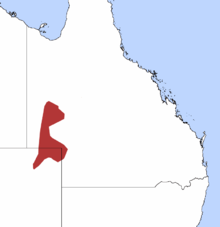Kowari
The kowari (Dasyuroides byrnei), also known as the brush-tailed marsupial rat, Kayer rat, Byrne's crest-tailed marsupial rat, bushy-tailed marsupial rat and kawiri, is a small carnivorous marsupial native to the dry grasslands and deserts of central Australia. It is monotypical in its genus.
| Kowari[1] | |
|---|---|
| Scientific classification | |
| Kingdom: | Animalia |
| Phylum: | Chordata |
| Class: | Mammalia |
| Infraclass: | Marsupialia |
| Order: | Dasyuromorphia |
| Family: | Dasyuridae |
| Subfamily: | Dasyurinae |
| Tribe: | Dasyurini |
| Genus: | Dasyuroides Spencer, 1896 |
| Species: | D. byrnei |
| Binomial name | |
| Dasyuroides byrnei Spencer, 1896 | |
| Subspecies | |
| |
 | |
| Distribution of the kowari | |
Description
The kowari is 16.5–18 cm long, with a 13–14 cm tail. Its diet consists mainly of insects and spiders, but probably also small lizards, birds or rodents.[1] It is known as a voracious predator. It lives in burrows, singly or in small groups. It emerges to hunt among grass tussocks for food. It breeds in winter, from May–October, and gives birth to litters of 5-6 young after a gestation of 32 days.[1]
The kowari is coloured ashy-grey, and its distinguishing feature is the brush of black hairs on the end of its tail, which differs from that found in the mulgaras (Dasycercus) in that it completely encircles the end of the tail. They have a life span of 3–6 years.[3]
Habitat
The kowari is found in stony desert areas of the Lake Eyre drainage basin, in north-eastern South Australia and southwestern Queensland. West of Lake Eyre it is declining, and is now possibly extinct in this area.[4]
Classification
The kowari is the only member of its genus. The genus name, Dasyuroides, indicates that it resembles Dasyurus, the quolls. First described in 1896 by Sir Walter Baldwin Spencer, it was for some time included in the genus Dasycercus. Spencer gave the species name in honour of a scientist and telegraph master called Patrick Michael Byrne, who was stationed at the telegraph station at Charlotte Waters, Northern Territory. He corresponded with Spencer and collected specimens for biological analysis for many years, and his work continues to contribute to scientists' understanding of central Australian mammals.[5]
Its common name is taken from the Diyari language.[6]
The Kowari is a member of the family Dasyuridae, and is most closely related to the mulgara.
Two subspecies of the kowari are recognised:[3]
- D. b. byrnei, found in the north-eastern part of the range;
- D. b. pallidior, found in the south-western part of the range.
Health
The Kowari has been known to be associated with oral squamous cell carcinomas (SCCs). The SCCs cause tumors to invade the oral cavity of the kowari. The tumors begin to cause swelling in the gums. Prior to seeing tumor formation, periodontal diseases are heavily present in the oral cavity. The kowari is not expected to survive after the SCCs have begun to develop and affect other regions of the body.[7]
References
- Groves, C. P. (2005). Wilson, D. E.; Reeder, D. M. (eds.). Mammal Species of the World: A Taxonomic and Geographic Reference (3rd ed.). Baltimore: Johns Hopkins University Press. p. 24. ISBN 0-801-88221-4. OCLC 62265494.
- McKnight, M.; Canty, P.; Brandle, R.; Robinson, T. & Watson, M. (2008). "Dasyuroides byrnei". IUCN Red List of Threatened Species. 2008: e.T6265A12592863. doi:10.2305/IUCN.UK.2008.RLTS.T6265A12592863.en.
- Aslin, H.J.; Lim, L. (1995). "Kowari". In Strahan, Ronald (ed.). The Mammals of Australia. Reed Books. pp. 59–61.
- Menkhorst, Peter (2001). A Field Guide to the Mammals of Australia. Oxford University Press. p. 52.
- Baldwin Spencer, Walter (1901–1902). Gibson, Jason (ed.). "Walter Baldwin Spencer's Diary from the Spencer and Gillen Expedition, 1901-1902" (PDF). Edited and annotated by Jason Gibson; transcribed by Heather Milton. Museums Victoria: 13, footnote 31. Cite journal requires
|journal=(help)CS1 maint: date format (link) - "Byrne, Patrick Michael". Spencer & Gillen. Retrieved 20 May 2019.
- Saunders, Richard; Killick, Rowena; Barrows, Michelle; Stidworthy, Mark (2017). "Oral Squamous Cell Carcinoma in Three Related Kowari ( Dasyuroides byrnei )". Journal of Comparative Pathology. 156 (2–3): 286–290. doi:10.1016/j.jcpa.2017.01.001. PMID 28196645.
